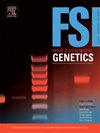通过机器学习推进生物地理祖先预测
IF 3.1
2区 医学
Q2 GENETICS & HEREDITY
引用次数: 0
摘要
像“狙击手”或“混合模型”这样的工具在生物地理祖先的法医科学中被视为最先进的方法。然而,它们还没有被系统地与其他学科中广泛使用的分类器进行比较。注意到遗传数据具有表格形式,本研究通过对法医分类器与TabPFN(一种用于表格数据的尖端通用机器学习分类器)进行基准测试来解决这一差距。比较使用诸如准确性(正确分类的比例)和ROC AUC等指标来评估性能。我们基于已发布的训练和测试数据集,在大陆内和大陆层面检查个体的分类任务。我们的研究结果揭示了不同方法之间的显著性能差异,TabPFN始终在准确性、ROC AUC和对数损失方面取得最佳结果。例如,在准确性方面,TabPFN在大陆范围内使用8个种群将SNIPPER从84%提高到93%,在欧洲间分类中使用10个种群将其从43%提高到48%。本文章由计算机程序翻译,如有差异,请以英文原文为准。
Advancing biogeographical ancestry predictions through machine learning
Tools like Snipper or the Admixture Model count as state-of-the-art methods in forensic science for biogeographical ancestry. However, they have not been systematically compared to classifiers widely used in other disciplines. Noting that genetic data have a tabular form, this study addresses this gap by benchmarking forensic classifiers against TabPFN, a cutting-edge, general-purpose machine learning classifier for tabular data. The comparison evaluates performance using metrics such as accuracy – the proportion of correct classifications – and ROC AUC. We examine classification tasks for individuals at both the intracontinental and continental levels, based on a published dataset for training and testing. Our results reveal significant performance differences between methods, with TabPFN consistently achieving the best results for accuracy, ROC AUC and log loss. E.g., for accuracy, TabPFN improves SNIPPER from 84% to 93% on a continental scale using eight populations, and from 43% to 48% for inter-European classification with ten populations.
求助全文
通过发布文献求助,成功后即可免费获取论文全文。
去求助
来源期刊
CiteScore
7.50
自引率
32.30%
发文量
132
审稿时长
11.3 weeks
期刊介绍:
Forensic Science International: Genetics is the premier journal in the field of Forensic Genetics. This branch of Forensic Science can be defined as the application of genetics to human and non-human material (in the sense of a science with the purpose of studying inherited characteristics for the analysis of inter- and intra-specific variations in populations) for the resolution of legal conflicts.
The scope of the journal includes:
Forensic applications of human polymorphism.
Testing of paternity and other family relationships, immigration cases, typing of biological stains and tissues from criminal casework, identification of human remains by DNA testing methodologies.
Description of human polymorphisms of forensic interest, with special interest in DNA polymorphisms.
Autosomal DNA polymorphisms, mini- and microsatellites (or short tandem repeats, STRs), single nucleotide polymorphisms (SNPs), X and Y chromosome polymorphisms, mtDNA polymorphisms, and any other type of DNA variation with potential forensic applications.
Non-human DNA polymorphisms for crime scene investigation.
Population genetics of human polymorphisms of forensic interest.
Population data, especially from DNA polymorphisms of interest for the solution of forensic problems.
DNA typing methodologies and strategies.
Biostatistical methods in forensic genetics.
Evaluation of DNA evidence in forensic problems (such as paternity or immigration cases, criminal casework, identification), classical and new statistical approaches.
Standards in forensic genetics.
Recommendations of regulatory bodies concerning methods, markers, interpretation or strategies or proposals for procedural or technical standards.
Quality control.
Quality control and quality assurance strategies, proficiency testing for DNA typing methodologies.
Criminal DNA databases.
Technical, legal and statistical issues.
General ethical and legal issues related to forensic genetics.

 求助内容:
求助内容: 应助结果提醒方式:
应助结果提醒方式:


